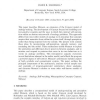Free Online Productivity Tools
i2Speak
i2Symbol
i2OCR
iTex2Img
iWeb2Print
iWeb2Shot
i2Type
iPdf2Split
iPdf2Merge
i2Bopomofo
i2Arabic
i2Style
i2Image
i2PDF
iLatex2Rtf
Sci2ools
JETAI
2006
2006
A self-watching model of analogy-making and perception
hin an abstract microworld of analogy problems. This approach differs from most other models of analogy in its insistence that concepts acquire their semantics from within the system itself, through perception, rather than being imposed from the outside. The present work extends these ideas by incorporating self-perception, episodic memory, and reminding into the model. These mechanisms enable Metacat to explain the similarities and differences that it perceives between analogies, and to monitor and respond to patterns that occur in its own behaviour as it works on analogy problems. This introspective capacity overcomes several limitations inherent in the earlier model, and affords the program a powerful degree of self-control. Metacat's architecture includes aspects of both symbolic and connectionist systems. The paper outlines the principal components of the architecture, analyses several sample runs and examples of program-generated commentary about analogies, and discusses Met...
| Added | 13 Dec 2010 |
| Updated | 13 Dec 2010 |
| Type | Journal |
| Year | 2006 |
| Where | JETAI |
| Authors | James B. Marshall |
Comments (0)

